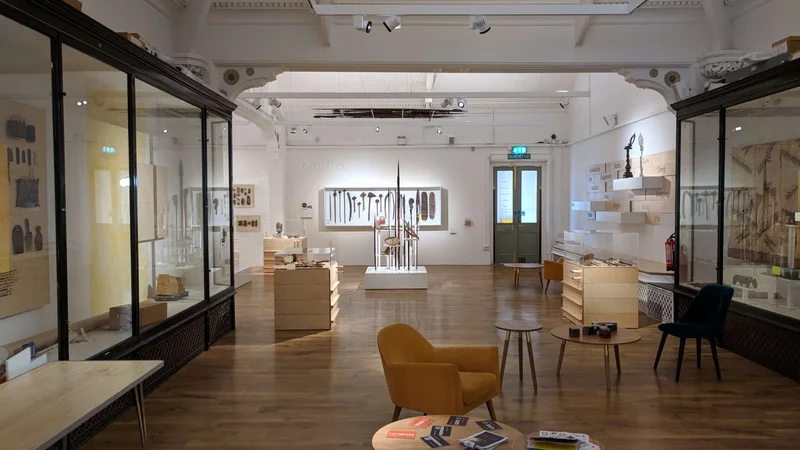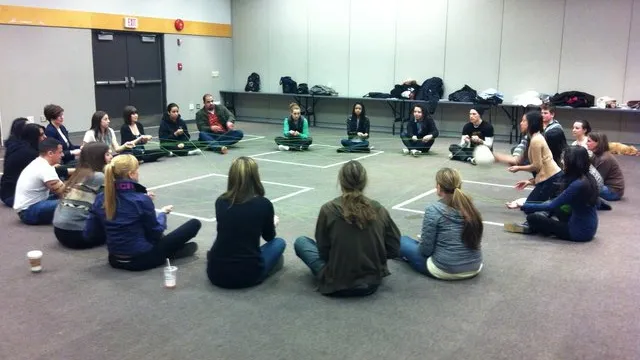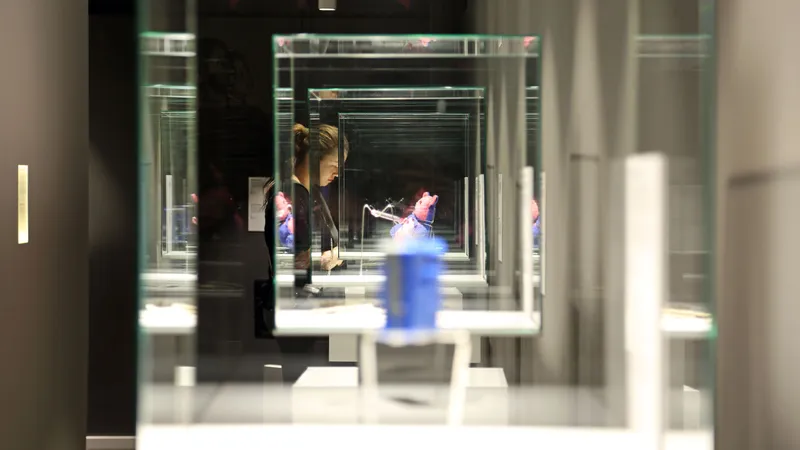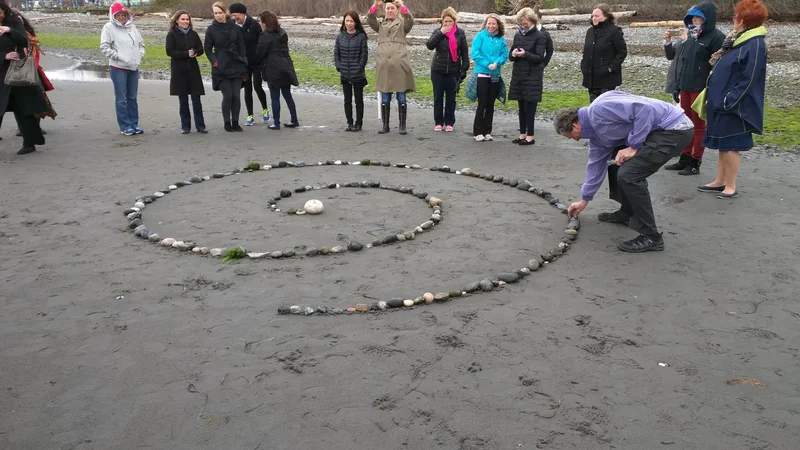Trauma-informed practice in museums benefits from a perspective that acknowledges the complex dynamics that arise from seemingly simple interactions. Rather than searching for causes and effects—this exhibit caused that reaction—we might think instead about how behavior and experience emerge from the relationship between people and their environments. A visitor encountering residential school artifacts brings their own history, their nervous system's learned patterns, their cultural context. The gallery itself offers certain invitations: where to walk, where to pause, what can be touched, where exits are visible. Staff presence (or absence) shapes what feels possible. All of these elements interact, and from that interaction, patterns emerge.
This perspective has practical implications. We must pay attention to what the environment invites people to do—not just what we intend them to do. A long, narrow gallery with a single entrance might invite steady forward movement, while an open space with multiple pathways and benches invites choice about pacing and engagement. A staff member standing near a difficult exhibit, calm and available, invites a different quality of experience than an empty room, however well-designed.
It means we notice constraints—the factors that shape what becomes possible. Some constraints are physical: the architecture of the building, the layout of objects, the acoustics of a space. Some are individual: a visitor's prior trauma, their capacity for self-regulation in the moment, whether they came alone or with others. Some are organizational: staffing levels, training, policies about when and how to intervene. These constraints don't determine outcomes, but they shape the range of what can unfold.
And it means we expect variability. No two visitors will move through an exhibition in precisely the same way, even when they encounter identical content. This variability is not a problem to be solved but information to be noticed. When someone pauses for a long time before a particular object, when their breathing changes, when they suddenly move quickly toward an exit—these fluctuations often signal something important. They might indicate a moment of deep connection, or the beginning of overwhelm, or the body's search for regulation. Learning to notice these shifts, and to offer supports that meet people where they are, is central to trauma-informed practice.
Museums as Living Systems
The museum, from this perspective, is not a static container but a living system. Visitors don't simply receive information; they actively explore, choose their paths, regulate their engagement. Staff aren't simply delivering content; they're part of the environment, offering presence and possibility. Objects aren't merely displayed; they invite relationship, sometimes resonating with visitors in unexpected and powerful ways. Safety, belonging, and healing emerge—or fail to emerge—from the ongoing dance between all these elements.
This way of seeing shifts our approach to training and design. Instead of teaching staff to follow scripts, we help them develop the capacity to notice, to adapt, to respond to what's actually unfolding. Instead of creating rigid pathways through exhibitions, we design spaces that offer choice: alternate routes, places to pause, visible exits, quiet alcoves. Instead of treating strong emotion as a failure of design, we recognize it as a natural response to difficult truths—and we create conditions where that emotion can be felt, contained, and processed.
The spiral labyrinth offers a useful metaphor. It has a single center—a place of stillness, perhaps, and integration—but the pathways toward that center are infinite. You can follow the central spiral, or move back and forth, or step across boundaries and wander. The labyrinth nudges but does not demand. It orients you to your own journey, your own choices. This is what trauma-informed museum practice aspires to: not controlling visitor experience, but creating conditions where meaningful, regulated exploration becomes possible.
Understanding How Trauma Happens
Trauma is an experience that exceeds our ability to manage the stress of the moment. In clinical terms, trauma breaks containment: we lose our self-regulation, we are drawn into instinctive coping, and we are usually unaware of what's happening. This is how trauma can happen invisibly and can go unseen. It is unusual for a person to notice that they are being traumatized while it's happening. One of the defining features of trauma involves the bypassing of (most of) our cognition: we just act—and we don't notice.
Traumatic situations involve high levels of emotional and psychological stress. That stress, in turn, damages our ability to modulate the thoughts and emotions we are experiencing. We enter into a primordial consciousness that is focused on survival. The situation does not have to be authentically threatening to our survival—most traumas are not. But in the moment, as events unfold, as the stress of exposure increases and our coping abilities vanish, the defenses of our psychology begin to crumble and the body takes over. The body possesses millions of years of evolutionary wisdom about survival. It knows—without hesitation, without doubt, without thinking—how it will respond. The human animal has perfected four distinct pathways of response: flight, freeze, orient, or fight. These pathways are deeply interwoven with childhood development and the nervous system. They are automatic, autonomic, and highly effective—at least, effective from the point of view of the body, which simply wants to survive.
But what if the situation is not a threat to our survival? What if we've just entered a museum gallery and we see a whip once used in the slave trade, the crushed remains of human beings, or photographs of a mass execution? There is no risk to our physical safety in these situations, no threat to our survival. But as trauma clinicians know, our particular vulnerabilities to trauma are the result of our previous histories, our experiences and our cultures, our prior exposure to trauma and its sequelae: what's happening now, in the gallery, is the direct result of what happened then, to me or my people.
We respond to these moments—flight, freeze, orient, fight. We seek to escape, or we shut down, or we become anxious, or we get angry. Perhaps we start with one response and then shift to another. Or we blend them together. People are different; many things can happen.
Although individual stress responses play out in a multitude of ways, they share one common feature: the responses lock. The deep coping mechanisms of the nervous system are not transient states when it comes to trauma. The patterns of behavior and emotion that accompany these states—driftiness, depression, fatigue, sleeplessness, irritability, impatience, overwhelm, and many others—persist long after the event. Sometimes they resolve in the days and weeks following exposure—people will say I felt weird after that experience, but I'm OK now—and sometimes they do not. In clinical practice, we often work with clients struggling to recover from traumatic situations that are decades in the past, and that often stretch back to early childhood.
In a museum setting, visitors can be traumatized vicariously by exposure to intense exhibitions. Or, their preexisting trauma can be re-awakened by such intensity. Volunteers can be traumatized by exposure to visitors in distress. In their efforts to support visitors and volunteers, staff can be traumatized both vicariously and directly. They can also become overwhelmed with compassion fatigue, or hollowed out by empathy depletion.
The Challenge of Trauma in Museum Contexts
As museums and galleries increasingly tackle themes involving trauma, they confront a basic challenge: such environments are not contexts for psychotherapy. Most museum staff are not counsellors. Trauma does not always (or even usually) fit neatly into the ways that museum educators design the intended experiences of visitors. Navigating trauma can be chaotic and disorienting, both for those experiencing symptoms and for those trying to help. Outcomes can be hard to define: what do terms like health, growth, support, or progress mean in the context of trauma? Things can go sideways quickly and with much damage to all.
What's required is a trauma-informed perspective scaffolded appropriately with training, personal development, and ongoing support. These elements are essential in preparing staff for situations that will inevitably arise—often in unexpected moments when people feel unprepared. But the scaffolding itself must be flexible. Trauma-informed practice is not a rigid protocol to be applied but a set of orientations and capacities that staff develop through practice, reflection, and mutual support. It's learning to notice the small signals—a visitor's breathing pattern, the quality of silence in a gallery, the moment when engagement tips toward overwhelm. It's developing the ability to be present without rushing to fix, to offer containment without controlling, to trust that people have their own wisdom about what they need.
When Activation Prevents Learning
Museums want people to learn something from their visits, to derive some meaning, to be impacted by exhibitions in ways that advance cultural values and contribute to society. This is especially true when exhibitions are focused on themes of social justice. In such cases, museums often want visitors to apply the lessons from their visits in ways that advance social justice aims: reconciliation, decolonization, reducing poverty and systemic racism, and so on.
However, if an exhibition emotionally activates a visitor, and if the stress of that activation reaches a critical level, the visitor will enter into one or more trauma responses—flight, freeze, orient, fight. The body will take over, seeking safety. Once this happens, the person is on autopilot: no new learning can happen, no insights can be gleaned from the exhibition, no lasting meaning can be achieved. The visitor will simply be trying to get through, to get away, to get out.
This creates a paradox at the heart of emotionally intense exhibitions. The museum's aim in exposing visitors to emotional intensity can run counter to its underlying aim of educating visitors and the public at large. A visitor who enters a residential schools exhibition and becomes overwhelmed by grief or rage may leave the museum with those feelings—but without the deeper understanding the exhibition sought to provide. They may remember the intensity of their emotional response but not the historical context, not the stories of resilience, not the pathways toward reconciliation. The activation itself becomes the experience, drowning out everything else.
This is a significant and often unacknowledged challenge for exhibitions dealing with traumatic histories and social justice themes. The very content that museums present as essential for public education can, if not carefully balanced with supports for emotional regulation, prevent the learning it was meant to facilitate. Getting the balance right—enough emotion to make meaning, but not so much that trauma responses are activated—is difficult and nuanced. It requires understanding not only what we want visitors to feel but also what happens in the nervous system when feeling becomes overwhelming. Much of this guide focuses on this balance: how to create conditions where difficult truths can be encountered, where emotions can be felt and honored, but where visitors retain enough regulation to actually integrate what they're experiencing into understanding, insight, and the possibility of meaningful action.
Building Organizational Capacity
Identifying and developing a trauma-informed cohort within the organization, and supporting them to learn trauma-informed skills and ways of being, are crucial steps in helping to build greater capacity for navigating these complexities. The initial training and leadership sessions begin this scaffolding: building shared language, practicing core interpersonal skills, and mapping organizational touchpoints—exhibitions, visitor services, research and collections, partnerships—where these skills are most needed. But the work does not end with training. It continues in daily encounters, in peer support, in the slow cultivation of a culture where care is expected and practiced.
An Ecological Approach
The museum is an ecological system with many layers, levels, and networks that extend both within and beyond the museum's walls. One of the defining features of trauma involves the breaking of boundaries across and between such systems and structures. Accordingly, trauma-informed initiatives are most effective when they include as many aspects of the ecology as possible—and, in particular, those in positions to make decisions about positive changes to that ecology.
One of the guiding principles of this work, therefore, is to include participants from different groups within the organization including those in executive positions, in management and leadership, and the board. Those who establish the vision and direction of the institution can play a unique role in supporting and advocating for trauma-informed practices that will impact everyone. But equally important are those who work directly with collections, who greet visitors at the door, who design exhibitions, who coordinate partnerships with community groups. Each person, in their particular role, shapes the environment. Each contributes to whether the museum becomes a place where difficult truths can be encountered with some measure of safety, or a place where harm is inadvertently perpetuated.
The Path Forward
A main goal of trauma-informed practice is to create capacity for museums to be organizations that emphasize well-being and mental health—especially in the context of mandates to grapple with the complex and often traumatic issues of human rights, historical injustice, and contemporary struggles. The development of trauma-informed practices in many contexts—such as onboarding, training, collegial supports, research, and exhibition design—becomes an important outcome for those who participate in this work.
The general approach is to facilitate a process that encourages a foundation from which participants can learn how best to preserve and enhance their own mental health while also supporting one another, and their community partners, as they navigate—together—situations in which emotional intensity and trauma are normal and expected. This is to say, almost any situation in a museum involving contemporary issues of human rights.
Understanding trauma in museum contexts is not an academic exercise. It is the foundation for everything that follows: how we design exhibitions, how we train staff, how we respond to visitors in distress, how we build partnerships with affected communities. Without this understanding, even the best intentions can cause harm. With it, museums can become places where difficult truths are held with care, where people feel seen and respected, and where the work of bearing witness to suffering does not extract an unsustainable cost from those who do it.
Next
Guide Navigation
The introductory page of the guide provides the context and rationale for trauma-informed museum practices and includes an overview of each page.
Understanding Trauma in Museum Contexts explores how trauma operates as a complex, ecological phenomenon affecting visitors, staff, and community partners. It examines the neuroscience of trauma responses, the patterns that emerge from person-environment interactions, and why museums need this foundational knowledge.
Considerations for Trauma-Informed Training addresses the personal dimension of this work—why trauma-informed training must be fundamentally different from typical professional development, how to build skills safely, and the importance of self-awareness and empathy as foundations for supporting others.
Core Principles of Trauma-Informed Practice outlines five interconnected principles—safety, trust, belonging, empowerment, and empathy—that guide all trauma-informed work. These are not implemented once but practiced continually, shaping how exhibitions are designed, how staff interact, and how partnerships are formed.
Supporting Colleagues examines what it means to care for one another in workplaces where exposure to traumatic content is routine. It explores the skills of presence, the importance of boundaries, and how to create a culture where supporting each other becomes ordinary rather than exceptional.
Trauma-Informed Exhibition Planning addresses the challenge of creating exhibitions that convey difficult truths with honesty while respecting visitor wellbeing. It offers practical strategies for content advisories, visitor choice, regulation spaces, and creative engagement that honors both truth-telling and care.
Working with Community Partners explores how to build genuine, reciprocal partnerships with communities whose traumatic histories museums represent. It emphasizes the importance of multiple sessions over time, incorporating creative work alongside discussion, and creating conditions where trust can develop.
Sustaining the Practice addresses how trauma-informed approaches become embedded in organizational culture rather than remaining isolated initiatives. It explores onboarding, documentation, leadership modeling, policy alignment, and the long-term work of creating environments where care is expected and practiced.






